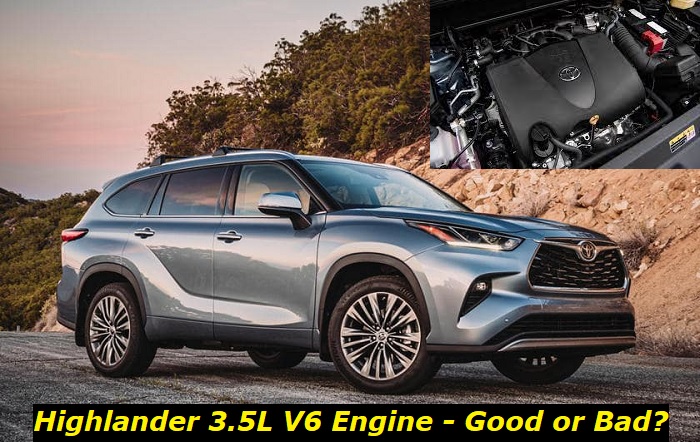The Toyota Highlander is without a doubt one of the most dependable mid-size crossover SUVs on the market. It houses an engine with enough power to push its bulky body, it has a three-row seating that can comfortably accommodate passengers, and it's built to last for decades. Unfortunately, like other vehicles, it can develop issues as it accumulates mileage and when it is regularly subjected to rough riding conditions.

Key features and my opinion about the engine
- Production years:2015-now
- Average lifespan of 2GR-FKS:190,000-220,000 miles
- Fuel supply type:combined injection (direct + port)
- Power range:280-315 hp
- Fuel efficiency:average
- Engine block material:aluminum
- Engine reliability score:medium
- The most common problems:oil leaks are common, uneven idling RPM, low-pressure fuel pump problems, water pump issues.
Toyota Highlander 3.5L V6 Engine Longevity
The Toyota Highlander 3.5L V6 2GR-FKS engine possesses the same longevity displayed by most other vehicles under its brand. It is estimated to cover a range of 250,000 to 300,000 miles before requiring an overhaul or replacement.
This means that the engine in your Toyota model should last for around 16 to 20 years based on the average driving times in the US. It should be noted though that these should also be coupled with regular maintenance and the practice of fixing minor problems before they even transform into major issues.
Common Problems Found in the Toyota Highlander 3.5L V6 Engine
There are problems that the Toyota Highlander 3.5L V6 engine is known for. However, when we say "common" we are certainly not pointing to the fact that they are evident in all units of the SUV. What we mean is that these are only the issues that make up most of the complaints about it.
With that out of the way to avoid a misunderstanding, here are the most common problems found in the power unit:
1. Fuel Pump Failure
A major cause of concern with the 2020-2024 Toyota Highlander 3.5L V6 engine is its high possibility of fuel pump failure. If the low-pressure fuel pump seizes, it could lead to the SUV stalling. This can be a serious safety hazard, especially if the vehicle is traveling at high speeds.
If you're driving the Highlander and notice any of the following symptoms, it's possible that the fuel pump has failed and you should take your SUV to a mechanic as soon as possible:
- The engine sputters or stalls unexpectedly.
- There's a decrease in power or performance from the engine.
- The engine starts making strange noises.
- The Check Engine light comes on.
While these symptoms can be caused by other issues, they're all indicative of fuel pump failure, too. To confirm whether or not the fuel pump is the problem, your mechanic will likely hook up a diagnostic tool to the SUV's computer. They may also perform a fuel pressure test.
A malfunctioning fuel pump has to be replaced immediately. This is a fairly straightforward repair, but it can be expensive because the fuel pump is located inside the gas tank. In the Highlander, the entire gas tank will need to be removed in order to access the fuel pump.
Replacing a failed fuel pump is the only way to fix the problem. However, there are some things you can do to try and prevent the pump from failing in the first place. For example, make sure you always use fresh gasoline and don't let your SUV's gas tank get too low. In addition, see to it that the filter is in good condition. These measures won't guarantee that your fuel pump won't fail, but they may help extend its lifespan.
In some instances, debris coming from flaking components or dirt may impede the operation of the pump. In this case, it is advised to take your vehicle to a mechanic and have them clean the fuel tank. This will clear any debris that may have gotten into the pump that's impeding its proper operation.
2. ECU Malfunction
As with other vehicles with a very complex set of technological features, a sizeable number of Toyota Highlander units have suffered from programming errors causing its Start/Stop operation to malfunction.
Basically, the SUV's auto start/stop function turns off the engine when the vehicle comes to a complete stop. When you let go of the brake pedal, the system will restart the engine. This is intended to save fuel and lower emissions.
However, due to a programming error, the Highlander's Start/Stop system may not restart the engine even when it is supposed to. This can happen when the vehicle is stopped on an incline.
The good news is that Toyota has already issued a recall for this problem and they will be reprogramming the affected vehicles' computer systems free of charge. So, if you own a Toyota Highlander and it suffers from this problem, simply bring it to your nearest dealer and they will take care of the rest.
The solution for this normally involves reflashing or updating the engine control unit (ECU) with new software from Toyota to fix the glitches. If that does not fix the problem, the ECU hardware itself may need to be replaced.
3. Sensor Issues
Sensor issues can feed the wrong information to your vehicle's computer, which may result in certain errors falsely triggering. In some cases, these may result in performance problems such as your vehicle entering into limp mode as a safety measure.
Limp mode is a security feature in modern vehicles that activates when the engine or transmission control unit detects a fault. When it detects a problem, limp mode turns off less important parts of the unit, such as the air conditioning, and reduces the vehicle's speed.
Other issues may include:
- Check Engine light activating on the dashboard.
- Fault codes randomly triggering.
- The engine not starting at all.
- The engine running very roughly.
If you're experiencing any of these problems, then it's likely that one or more of your sensors is malfunctioning.
When diagnosing sensor problems, always start with the simplest and most common causes first. In most cases, a dirty or loose sensor is the culprit. Try cleaning or tightening the sensor before moving on to other potential causes.
If the sensor is not the problem, then you may need to check the wiring leading to it for any faults. For a good measure, you can use a multimeter to check for the continuity or resistance of the wiring to determine its quality. If the wiring is damaged or is no longer allowing electricity to flow freely, it will need to be replaced.
Oftentimes, the sensor itself may be faulty and will need to be replaced. When doing this, make sure to use a sensor that is compatible with your vehicle.
If you're still having problems after trying all of these things, then the computer itself may be at fault. In this case, you'll need to take your vehicle to a mechanic or dealership for further diagnosis and repairs.
4. Oil Leak
The VVT-i oil line has been known to rupture prematurely. This can be a source of a massive leak that can affect the ground, engine, and undercarriage. The low engine oil alert and engine oil pressure warnings will illuminate if the oil line breaks while the vehicle is in operation. If this occurs, pull to the side of the road and stop the engine immediately. If you continue to drive with a damaged oil line, the quality of your engine may get compromised.
Many factors can cause an oil leak, so it's important to accurately diagnose the problem before trying to fix it. A common symptom is a burning oil smell coming from the engine area. If you notice this, be sure to check your engine oil level and appearance. If the oil level is low or the oil looks dirty, this could indicate an oil leak.
Other common symptoms of an oil leak include:
- Oil spots on the ground where you park your car.
- Low engine oil level.
- Burning oil smell coming from the engine area.
- Random or constant engine misfires.
Many factors can cause an oil leak aside from the ones mentioned, so it's important to accurately diagnose the problem before trying to fix it.
One common cause of an oil leak is a faulty oil filter. The oil filter is responsible for trapping contaminants that can damage your engine. Over time, the oil filter can become clogged and fail to do its job properly. This can allow contaminated oil to flow through your engine, causing an oil leak.
Another common cause of an oil leak is a faulty gasket or seal. These components are responsible for sealing the connection between two surfaces. If a gasket or seal deteriorates, it can allow oil to leak out.
A qualified technician will be able to diagnose the cause of your oil leak and recommend the best course of action. In some cases, a simple repair such as replacing a gasket or seal may be all that's needed to fix the problem. More extensive repairs may be needed depending on the severity of the issue.
If you have an oil leak, it's important to have your vehicle repaired as soon as possible to avoid further damage. Waiting too long to fix an oil leak can lead to serious engine damage that can be expensive to repair.
2020-2024 Toyota Highlander 3.5L V6 Engine Key Specs
The Toyota 3.5L V6, also known as the 2GR-FKS, was used in a variety of Toyota, Lexus, and Lotus vehicles from 2005 to the present. Depending on the model, the North American versions of the engine produce between 290 and 315 horsepower. A few of the 3.5 V6s have a supercharger and can produce up to 430 horsepower.
Conclusion
Amid the problems unveiled here, the Toyota Highlander is an amazing product if its overall packaging is put into consideration. The engine also remains superbly reliable compared to its direct rivals in the market because the occurrence of the issues listed here are just minimal and many of its units have lasted without them.
About the authors
The CarAraC research team is composed of seasoned auto mechanics and automotive industry professionals, including individuals with advanced degrees and certifications in their field. Our team members boast prestigious credentials, reflecting their extensive knowledge and skills. These qualifications include: IMI: Institute of the Motor Industry, ASE-Certified Master Automobile Technicians; Coventry University, Graduate of MA in Automotive Journalism; Politecnico di Torino, Italy, MS Automotive Engineering; Ss. Cyril and Methodius University in Skopje, Mechanical University in Skopje; TOC Automotive College; DHA Suffa University, Department of Mechanical Engineering






Add comment